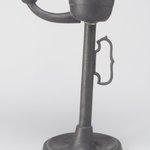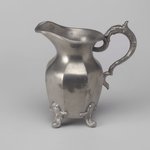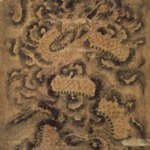
Jar with Lid
Asian Art
On View: Asian Galleries, South, 2nd floor
Brown-glazed ceramic wares were used in many Korean kitchens for storage and serving of foodstuffs. More expensive porcelain and metal dishes were used as table settings if a household could afford them. Although they are often called honey pots, lidded small jars like these were used for a wide variety of sauces and pickled vegetables. Many Korean homes produced and stored large quantities of fermented and salt-preserved foods in very large ceramic jars that were kept outside. Cooks used these smaller jars when they retrieved those ingredients for use in the kitchen.
MEDIUM
Stoneware, glaze
DATES
19th century
DYNASTY
Joseon Dynasty
DIMENSIONS
Jar:
Height: 5 7/16 in. (13.8 cm)
Diameter at mouth: 3 1/4 in. (8.2 cm)
Diameter at base: 3 1/4 in. (8.2 cm)
Diameter at widest point: 5 3/4 in. (14.6 cm)
Lid:
Height: 1 1/16 in. (2.7 cm)
Diameter at mouth: 2 1/16 in. (5.2 cm)
Diameter at base: 3 3/8 in. (8.5 cm) (show scale)



COLLECTIONS
Asian Art
ACCESSION NUMBER
1991.74.36a-b
CREDIT LINE
Gift of the Estate of Charles A. Brandon
EXHIBITIONS
MUSEUM LOCATION
This item is on view in Asian Galleries, South, 2nd floor
CAPTION
Jar with Lid, 19th century. Stoneware, glaze, Jar:. Brooklyn Museum, Gift of the Estate of Charles A. Brandon, 1991.74.36a-b. Creative Commons-BY (Photo: Brooklyn Museum, 1991.74.36a-b.jpg)
IMAGE
overall, 1991.74.36a-b.jpg. Brooklyn Museum photograph
"CUR" at the beginning of an image file name means that the image was created by a curatorial staff member. These study images may be digital point-and-shoot photographs, when we don\'t yet have high-quality studio photography, or they may be scans of older negatives, slides, or photographic prints, providing historical documentation of the object.
RIGHTS STATEMENT
Creative Commons-BY
You may download and use Brooklyn Museum images of this three-dimensional work in accordance with a Creative Commons license. Fair use, as understood under the United States Copyright Act, may also apply.
Please include caption information from this page and credit the Brooklyn Museum. If you need a high resolution file, please fill out our online application form (charges apply).
For further information about copyright, we recommend resources at the United States Library of Congress, Cornell University, Copyright and Cultural Institutions: Guidelines for U.S. Libraries, Archives, and Museums, and Copyright Watch.
For more information about the Museum's rights project, including how rights types are assigned, please see our blog posts on copyright.
If you have any information regarding this work and rights to it, please contact copyright@brooklynmuseum.org.
RECORD COMPLETENESS
Not every record you will find here is complete. More information is available for some works than for others, and some entries have been updated more recently. Records are frequently reviewed and revised, and we welcome any additional information you might have.






































